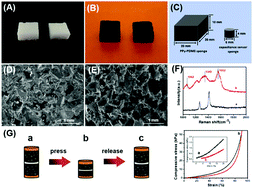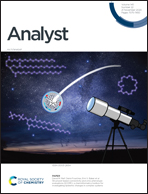A polypyrrole-polydimethylsiloxane sponge-based compressible capacitance sensor with molecular recognition for point-of-care immunoassay†
Abstract
A highly compressible and all-solid-state polydimethylsiloxane (PDMS) sponge-based flexible capacitance sensor modified with polypyrrole (PPy) was designed as the signal readout for the sensitive immunoassay of prostate-specific antigen (PSA). This system mainly consisted of a compressible capacitance sensor, immunoreaction protocol and gas delivery channel. The capacitance sensor was connected to a single microplate by a syringe, whereas the immunoreaction was carried out in the microplate. The conjugated catalase with the detection antibody via biotin–streptavidin interaction could trigger gas generation to cause a pressure change, thus resulting in the increase in the capacitance of the PPy-PDMS sponge observed with an LCR-6100 digital bridge capacitance meter. By coupling with the capacitance sensor, the capacitance change could be monitored in real time to achieve portable detection of PSA. Under the optimal conditions, the compressible supercapacitor PPy-PDMS sponge showed great electrochemical performance and remained stable under compressive strains. The capacitance increased with increasing target PSA concentration within a dynamic working range of 0.1–50 ng mL−1 at a detection limit of 57 pg mL−1. Moreover, acceptable reproducibility, precision and high specificity were obtained from PSA analysis, and were in good accordance with the commercial PSA ELISA kit.



 Please wait while we load your content...
Please wait while we load your content...